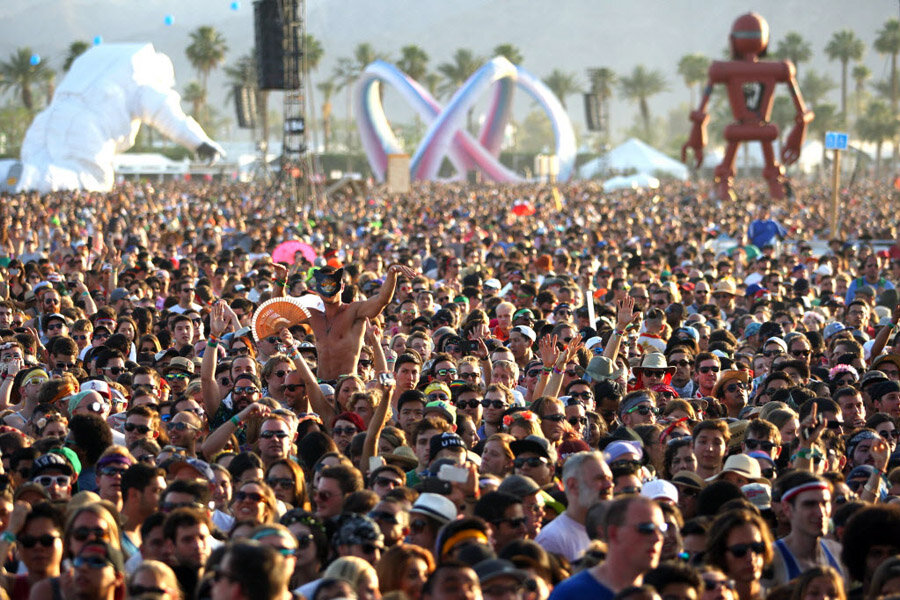Coachella's young audience attracts marketing maelstrom
Loading...
| INDIO, California
When it first started in 1999, Coachella was a couple of stages and a dance tent. Tickets were $65. A few dusty stands sold hot dogs and Cokes. It was the end of grunge and the start of a new millennium, and it was all about the music. All for one weekend.
Now, tickets start at $375. Gourmet menus and VIP packages abound. And dozens of companies have hopped on theCoachella bandwagon, turning the music festival — now two back-to-back weekends — into a marketing hotspot. Adidas, Details magazine, Harper's Bazaar and Lacoste are just some of the brands that host offsite festival events for stylish celebrity guests.
Rolling Stone executive editor Nathan Brackett said the Coachella Valley Music and Arts Festival has become a destination for fans and brands because organizers consistently deliver compelling lineups of diverse and unconventional musical acts. A reunited OutKast headlines this year's festival, and other acts include Arcade Fire, Lorde, Haim, Lana Del Rey and Muse.
"They made great, cool choices and now they're enjoying the fruits of that," he said.
The Coachella crowd may be there to listen to music under the hot desert sun, but the retailers are there for the celebs and the crowd, which is young, hip and with money to spend.
"Music is a marketing platform for many lifestyle brands," said marketing expert Tom Julian, a director of merchandising and retail consulting firm The Doneger Group. "The festival circuit becomes as important as an ad campaign or social-media campaign. ... It just gets back to: This is where the millennial is, and this is a way to connect."
The idea is to transfer Coachella's cool factor to the brand itself, and translate that into sales: Festival fashion becomes synonymous with spring style for young consumers, right at the start of vacation season. Coachella's casual, summery look provides a sweet spot for fashion brands, said Megan Reynolds, senior shopping editor for Harper's Bazaar, which held its second annual event at this year's festival.
"It's so important not only because it's the only (event) of its kind — fashion is usually so focused on being dressed up all the time," she said. "It's kicking off this whole season."
For women, the look is super-short denim cutoffs, ankle boots, bikini top and/or sheer, macrame blouse, and floral headband. For guys, it's board shorts and an Abercrombie-and-Fitch body.
Celebrities embrace the dress code. De-facto Coachella mascot Vanessa Hudgens rocked the uniform perfectly in a shot on Instagram on Coachella's opening weekend. Katy Perry paired jean shorts with a mesh crop top at Bazaar's off-site pool party. Selena Gomez threw a crochet white dress over her bikini-and-shorts combo. Julianne Hough and Sarah Hyland also followed the rules.
Kellan Lutz and Joe Jonas sported buff biceps in drapey tank tops. Steven Tyler wore a sheer shirt at the Lacoste party, where Emma Roberts paired an alligator-logo top with the requisite denim shorts.
Brands set up shop at the posh Palm Springs hotels nearby where the beautiful people stay, then offer parties, merchandise and festival access to celebrities in exchange for publicity and the attention of a coveted Twitter audience. Social media gives the festival a reach far beyond music fans and readers of celebrity magazines.
"People have Instagram accounts just for Coachella fashion," Reynolds said.
The brands have followed the stars, Reynolds said.
"It really started as a place (stars) just wanted to go. It was like a more digestible version of Burning Man: You could be at a festival that wasn't totally marketed and had underground appeal," she said. "Now it's not like that, but people still really like it. ... It's evolved into just a fun place to be. We like the audience there, and a lot of the fashion industry is coming on board. It's taken on its own ambiance for the weekend."
Other festival sponsors, including Heineken and Fruttare, host "houses" on the concert grounds where all 100,000 attendees are invited to cool off, hear tunes and sample products (Representatives for festival promoter Goldenvoice declined to be interviewed for this story).
H&M, a festival sponsor for the last five years, also held its second annual Coachella after-party last weekend, drawing such stars as Jared Leto, Robert Pattinson, Kate Bosworth and Fergie. Company spokeswoman Marybeth Schmitt described the festival as "the ideal venue" to launch new H&M lines — it announced its collaboration with designer Alexander Wang last weekend.
"It is extremely exciting for us to be able to reach a significant number of our target consumers," she said in a statement. "The music culture has always been a source of inspiration for our collections — music is the perfect complement to fashion."







